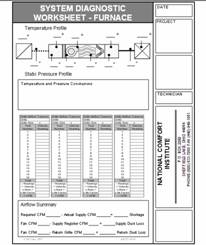While profiling may be an unpopular word in airports these days, it remains the title of one of the best diagnostic procedures we’ve ever brought to you. You can profile an HVAC system by taking a series of temperature, pressure or airflow readings across it, and recording them on a system graphic. When you study the profile you will quickly see system defects that may not become visible by any other means.
Recently we gave our air diagnostic training a complete overhaul. Some of the most valuable additions to the training are the system profiling exercises. We have included straight line graphics of systems that include furnaces and air handlers, coils, filters, ducts and grilles. Along the system graphic, we include a series of tests taken from one end of the system to the other.
As you study a system profile, a clear picture of the systems’ performance appears. By calculating system ?t or ?p (Temperature or pressure changes) across the system you begin to see its flow and changes. The system defects become immediately apparent and the solution is quickly obvious.
Once the defects are apparent, the solutions to the system performance problems become clear and surgical.
Pressure Profile
 For years we’ve used profiling as a reporting method in commercial balancing. Up until now, we only profiled large commercial equipment to analyze the heart of the system. Today, by plotting pressure throughout the entire system, you can easily evaluate total system performance.
For years we’ve used profiling as a reporting method in commercial balancing. Up until now, we only profiled large commercial equipment to analyze the heart of the system. Today, by plotting pressure throughout the entire system, you can easily evaluate total system performance.
Profiles quickly gather all the test data necessary to calculate system pressure drops. As you enter pressure measurements on the system graphic from one end to the other, you can subtract readings to find the pressure drops over any component or section of the system.
Subtract the pressure after a coil from the pressure before the coil and the difference is the pressure drop over the coil. In a residential furnace the ideal budget for a coil is no more than 40% of the fan rated total external static pressure. If it’s more than that, “Houston, we have a problem,” and a solution to the problem becomes the next step.
Calculate the pressure drops over air filters. Ideally no more than 20% in furnaces and up to 50% in heat pump air handlers should be taken by the filter (because there’s no remote cooling coil pressure drop in the pressure budget in an air handler). If the pressure drop is under budget, move on, of not, a solution must be created.
You can also evaluate the pressure drop of any other system component. Duct system pressure drop should not exceed 40% of fan rated pressure. A single duct fitting or transition should rarely exceed 5% of rated fan pressure. You’ll be amazed by the effectiveness of pressure profiling in your daily system diagnostic routines.
It’s refreshing to pull your head out of the box when analyzing a system.
Temperature Profiles
The same principles apply to temperature diagnostics when profiling as they do to measuring and recording system pressures.
Use a straight line system schematic to gather the temperatures from one end of a system to the other. Then subtract one temperature from the other and compare the results to practical NCI standards.
Ideally, the temperature rise over a gas fired air heat exchanger should be 35 to 65 degrees. As many of us have mastered combustion testing and BTU measurement we have learned by our experience unless we’re near the top of that scale, our hopes of system performance anywhere near 90% or better are pretty slim.
Likewise if a temperature profile shows a dry bulb ?t over a cooling coil of only 13 degrees, we have identified the culprit in our investigation.
Duct losses are easily identifiable using temperature profiling. If the supply plenum measures 130 degrees and the farthest supply register’s air temperature measures only 120 degrees, the system is experiencing some significant thermal losses.
The same hold true for the other end of the system. If we read 70 degrees at the average return grille and the temperature drops to 60 degrees by the time it reaches the return plenum we have a 10 degree temperature loss through our return duct. It’s time to whip out our hood or anemometer and chase down some serious return duct leaks.
Profiling return and outside air also quickly isolates the load a fresh air duct is adding to a building. The temperature profiling list of great diagnostic tests goes on.
Airflow Profiles
Plotting airflow measurements along a system schematic will reveal some real winners and losers. Find fan airflow by measuring static pressure and plotting fan CFM from the manufacturer’s fan tables – or by performing a traverse a t the return drop. Next, measure the airflow at the return grilles. Fan airflow minus return grille airflow isolates return duct leaks.
Measure the airflow at the registers on the supply side of the system. Subtract register airflow from the fan airflow to find supply duct leakage as well.
We have included 2 one-page system diagnostic worksheets to make it easy to put profiling to work for you. We have one for furnaces and another for heat pump air handlers. Each includes an area for recording your pressure profiles, temperature profiles and airflow profiles. Download what you need, customize the worksheet with your company name and put profiling to work for you right away.
